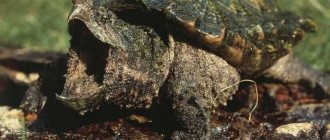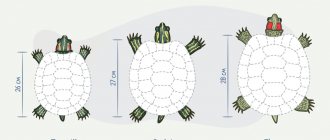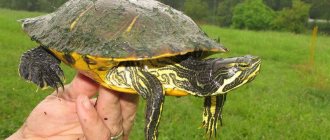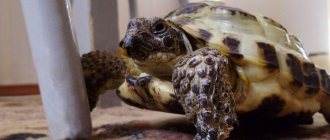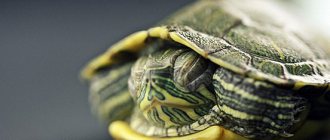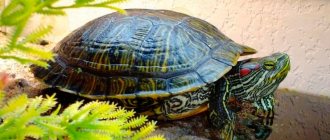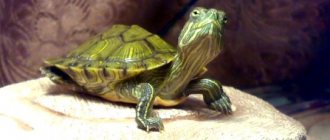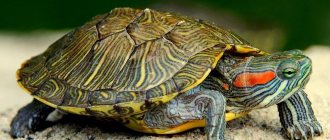How to determine if your pet is hibernating
It is quite difficult to distinguish hibernation from death if you do not know certain signs of a living reptile in suspended animation and a dead turtle.
What signs indicate the death of a pet:
- Open mouth.
- Lack of response to light and pain. Shine a light into the reptile's eyes and try to prick its paw with a toothpick.
- Sunken eyes (does not always indicate death).
- Unnatural color of mucous membrane. In living individuals it has a pinkish tint, in dead ones it is gray with a bluish tint.
- Lack of response to heat. Place the reptile in warm water or near a light heat source.
- Rotten corpse smell. The smell appears a couple of days after death. You will most likely notice obvious external signs of decomposition.
If the signs of death are not obvious, for example, sunken eyes, you should contact a specialist at a veterinary clinic, who will determine what is wrong with your pet.
Conditions for keeping red-eared turtles
For one animal you need an aquarium with a volume of one hundred to one hundred and fifty liters and land connected to water using a rough ladder. If there is insufficient space, the turtle will not swim or move.
In addition, the following conditions must also be met:
- The surface of the land in the turtle's home should be large enough, sloping, rough and gradually rising. Special islands sold in stores meet all the necessary requirements;
- The water temperature in the aquarium should be higher than room temperature. To heat it, you should purchase a thermostat;
- the air above the island should also be warm, so it is recommended to install an incandescent lamp above it;
- the island should be at a level of thirty centimeters from the edge of the aquarium. If it is located close to the edge, nimble pets can escape;
- The water is cleaned using external aquarium filters. The frequency of water changes depends on their effectiveness. The cleaner the water in the aquarium, the faster the young turtles will grow;
- animals need sunlight, so in the summer they need to be walked with, and in the winter irradiated with ultraviolet light. A UV “Tanning Lamp” is suitable for this; it will need to be used three times a week for four minutes at a distance of thirty to fifty centimeters.
During a walk, the animal should be protected from direct sunlight, walking dogs and crows.
How to care for red-eared turtles
To keep a turtle you will need an aquarium, choose the size yourself, but keep in mind that they grow quickly, in the future they will need a lot of space. It is also worth building an island for access to land. The island must be installed so that part of it is covered with water; it must be secured well so that the turtle does not get hurt; Also, the most important thing is that the island must be heated and warm so that the reptile can bask on it. It is also worth purchasing a heating lamp to maintain the required temperature; you also need a UV lamp, which will help properly absorb calcium in the body so that the turtle does not suffer from rickets or a bent shell.
To keep your turtle healthy, you need to monitor its diet.
.
The types of food are very diverse; they can be vegetables, special foods, insects or plants. The main condition is a large amount of calcium in the products, which is necessary for the formation of the shell. The diet should be age appropriate.
Young reptiles are less demanding, while adults need plant food, which should be in abundance. Water is the main condition for keeping the red-eared turtle. There should be a lot of water and it needs to be changed often, because... pets live in this water, eat, and go to the toilet. Otherwise, reptiles may get sick from microbes that develop in dirty water.
It is necessary to constantly maintain the water temperature at 23 °C and above. At low temperatures, the reptile may go into hibernation, from which it may not emerge, and then die from dehydration.
Everyone noticed that the turtle’s claws and beak grow very quickly, and they also require special care. As the claws grow, they need to be trimmed, otherwise the pet will not be able to move on land. You can do this yourself or by visiting a veterinary clinic.
It would be a good idea to watch the following video
Dangerous! Never trim the growing beak; it provides turtles with the opportunity to eat meat.
Who is better boy or girl
Visual differences between males and females in turtles appear after puberty is complete. Until two years of age, it is impossible to accurately determine whether a boy or a girl is hiding under the shell. For solitary confinement, the difference is not fundamental.
Females of any turtle species will carry out their natural program of laying eggs, even without contact with a male. If more than two years have passed since the last meeting with a representative of the opposite sex, there will be no offspring. The reptile's body requires vitamin support during this period. In rare cases, the process can negatively affect the health of the pet. Male land turtles are usually noisier than females. They are more active and more likely to show aggression.
If you need to choose a second turtle, the introduction will have to be carefully planned. Boys of any breed rarely get along with each other. Girls are more suitable for pair housing. When an opposite-sex couple lives together, the male can oppress the female. Turtles feel comfortable alone.
Reasons for refusing to eat
One of the first reasons why a turtle does not eat is simple overfeeding. But besides this, there are a number of situations that can affect the reptile’s appetite.
It is immediately worth noting that turtles are cold-blooded animals and due to changes in the environment or living conditions, they can significantly slow down their metabolism. Adults can go without food for up to three months. In this case, up to 40% of body weight is noticeably lost. It is worth understanding that prolonged fasting can result in exhaustion and negative health consequences.
Conditions in the terrarium
The terrarium you create should be comfortable for the animal in all respects. Conditions should resemble natural habitats. Any changes can affect the mood and health of turtles:
Temperature. This may be the root cause and answer to the question of why the turtle does not eat for a long time. The optimal temperature should be between 25-27 degrees. If a turtle is cold, it becomes inactive, may sleep a lot and even hibernate. Lighting. Poor lighting can also affect reptiles' appetite and mobility
It is important that the lamp has ultraviolet radiation. It is this kind of lighting that helps the body produce vitamin D3. Water
Make sure there is always clean and fresh water in the sippy cup. Often a turtle may refuse to eat due to thirst. Food. Perhaps your pet is not satisfied with the food offered. Remember that food should be varied and appropriate for food supplies. In addition to plants, try giving herbivorous turtles branches of fruit trees and sunflower seeds. For predators, provide a variety of animal foods. It happens that a reptile simply loves a certain product and is waiting for it.
Pregnancy. If a turtle does not eat during pregnancy, this means that the animal feels restless, so it may lose its appetite for 2-3 months. Puberty. This is an important factor that can affect your pet's appetite. Eye Diseases If your reptile feels well and is not pregnant, but still refuses to eat, pay attention to its eyes. The cause of starvation may be conjunctivitis. The fact is that turtles find food through vision (not smell), and swollen eyelids can simply interfere with the search for food.
In addition, if there are two individuals of the opposite sex in your aquarium, then mating games can be the result of poor appetite. Of course, at this moment there is no time to eat, but after mating the animals will definitely renew their strength and eat more than they should. There is no need to be surprised or worry about this.
Disease
Could your turtle be sick? After all, sick turtles eat poorly, become apathetic and lethargic. Exhaustion of the animal can lead to the worst, and the worst is death. The most common cause of digestive and nutritional problems is intestinal parasites. Therefore, owners of exotic animals should, if they suspect digestive problems, collect the animal’s feces and submit it to a veterinarian for analysis.
So what can you do if your reptile stops eating? First of all, you need to examine the turtle externally, monitor its behavior and general condition.
Let's look at the diseases and their external signs:
| № | DISEASE | EXTERNAL SIGNS |
| 1. | Conjunctivitis | Swollen eyelids, pus is often visible under the eyelids |
| 2. | Pneumonia | An aquatic turtle floats to the surface of the water and does not sink, breathes through its mouth, wheezes and blows bubbles, and falls on its side. |
| 3. | Tympany of the stomach | Rolls over on its side, sits on the surface of the water (on a stone or snag), does not drown |
| 4. | Diseases of the oral cavity (herpes, necrotizing stomatitis or herpesvisor) | Heavy breathing, decreased activity, presence of yellow flakes in the mouth |
| 5. | Kidney failure | Passivity, presence of blood under the abdominal shell. Unfortunately, these symptoms appear only in the last stage. In this case, treatment is already useless |
What to do when a disease is detected? In all cases, you cannot do without a visit to a professional. If you react in time to external signs of illness, treatment will be quick and successful, and the animal will soon begin to eat well and lead an active lifestyle.
The land turtle does not move, does not eat Help!!
The reasons for loss of appetite range from improper care and puberty to the environment in the terrarium and diseases.
Feed your pet specialized food and approved products. Poor nutrition will cause not only loss of appetite, but also all kinds of intestinal diseases. The diet of an adult red-eared turtle necessarily includes meat, sea fish with bones, shrimp, and plant foods.
It is impossible to force a turtle to eat food it does not like.
Young individuals will not eat vegetables.
Binge eating
Often the animal refuses food when fed excessively. Young animals eat every day, and adults feed once every 2 days. Normalize the food system, watch your pet to find out how much food he needs.
If the portion is not eaten completely, the amount of food should be reduced.
Diseases
Diseases of internal organs do not manifest themselves externally. If the animals are lethargic, refuse to eat, and constantly try to sleep, then only a veterinarian can determine the cause. He will prescribe the correct treatment, recommend vitamins, and advise on diet.
Improper care
The most common mistake in content. Make sure that the temperature is maintained consistently within the range required for the specific breed. Reptiles cannot maintain their body temperature on their own. When exposed to hypothermia, they become lethargic, refuse to eat, get sick and die.
Aquatic rocks exhibit a lack of heat, remaining exclusively on the surface. If the reptile does not swim at all, pneumonia is possible.
Stress
Animals are subject to stress. Loud sounds, sudden movements, sudden changes in usual conditions - these factors lead to a refusal to eat. Eliminate sources of stress and your appetite will gradually return.
We suggest you read: Why does a cat have dilated pupils and what to do in such a situation
Overwintering
An individual hibernating accordingly refuses to eat. The pet becomes lethargic and inactive, constantly sleeping. Veterinarians do not recommend such overwintering at home, as it carries a risk of death of the animal. To avoid hibernation, ensure a constant temperature of around 30 degrees and clear daylight hours, or consult a professional.
If your pet is not eating on the 5th day after coming out of hibernation, take him to the vet. You may be exhausted, dehydrated, or have gout or liver failure.
Mating season
During puberty, males become more active, but eat much less than usual. After the mating season ends, food consumption will return to normal.
If your environment changes abruptly, it will take time to get used to it. Follow the animal’s usual routine and diet. Having gotten used to the new place, the pet will begin to eat. If you want to change the feeding plan, do it once the animal has settled down.
Getting used to captivity
Wild individuals trapped in a terrarium experience stress and often refuse food for a week. Be patient and create conditions in the room that are close to natural. If, even after habituation, the turtle does not eat well, reconsider the diet.
When constipated, a turtle will not eat anything. If your pet hasn't had a bowel movement in a while, consult your veterinarian to determine the exact problem.
Males can be quite aggressive towards each other. And the suppressed individual may not receive enough food or refuse it altogether. This state of affairs threatens the life and health of the animal.
If there are no changes and the turtle looks very emaciated, it needs to be seen by a doctor immediately.
The fact that you change the animal’s diet at the wrong time can lead to food refusal. For example, in case of untimely transfer of a young turtle to food for an adult.
Pay attention to your pet's stool. If a turtle is constipated, it will not eat. Swimming in warm water will help relieve constipation. In difficult cases, you have to give the turtle Vaseline oil. In general, a warm bath (water temperature up to 36 °C) should help.
Constipation is caused not only by poor diet, but also by dehydration. If your turtle doesn't eat but drinks a lot while taking a bath, be sure to pay attention to its urine. If the urine has changed color and there are sand impurities, contact a herpetologist about the problem.
Land turtles are slower and clumsier than freshwater turtles, but this fact has not stopped some species from being kept as pets. Since feeding is the most important component of keeping any animal, the AnyDayLife collection of tips will tell you what to feed land turtles.
Land turtles are distinguished by their phenomenal resilience and longevity, so it is in the interests of any breeder to properly care for their pet. After all, if you maintain good and strong health of the turtle with a balanced diet, the pet can be inherited by your children, since this family of turtles can live up to 50 and even 100 years or more.
Plant food for land turtles
Many species of land turtles are primarily herbivorous and feed on stems, leaves, and seasonal vegetables and fruits. If you have a garden, then in the warm season there will be no problems providing your pet with fresh herbs. Feed your land turtle with fresh leaves of lettuce, clover, horse sorrel, chicory, dandelion, vegetable tops, and young sunflower seeds. You can treat your pet with leaves of birch, linden and fruit trees.
If you collect such vegetation in nature, then under no circumstances pick off plants and leaves near highways and railways; choose a place at least a hundred meters away from the roads, or better yet, even further.
Introduce apples, pears, plums, apricots, peaches, bananas, carrots, tomatoes, cucumbers, sweet peppers, zucchini, eggplants, pumpkin into the plant diet of a land turtle; beets, all types of cabbage, and beans can be given once a week. During the season, the best treats for your pet will be melons, watermelons, and any berries.
We suggest you read: Bleeding from a cat’s nose: reasons why it bleeds, what to do
From plant foods, it is not recommended to give a land tortoise celery, spicy herbs, garlic and onions, sweet exotic fruits, cherries, citrus peels (citrus pulp can be given only in strictly limited quantities), fruit seeds, potatoes, and baked goods. You should not feed your turtle the same fruits or vegetables all the time; this will have a very bad effect on its health.
Also try to avoid purchased early vegetables and fruits, as their manufacturers do not spare chemical additives for such a harvest. If you grow your own vegetables and fruits, then you don’t have to worry about your pet’s health. And do not forget that it is strictly forbidden to give your pet spoiled vegetables and fruits.
In the diet of a land turtle, especially in winter, when there is not a great abundance of fresh herbs, fruits and vegetables, it is necessary to add mineral supplements and special vitamins.
Animal food for turtles
Although land turtles are herbivores, their development in captivity will not be complete without animal food. Once a week, food of animal origin should be added to the plant diet; as a percentage, it should be about 5% of the total diet. These can be hard-boiled eggs, gammarus, washed earthworms, garden snails.
Among the food of this category, it is not recommended to give the turtle locusts, grasshoppers, crickets, milk, pork, beef, but you can give fish, which is recommended to be kept in boiling water for a couple of minutes before feeding.
Other feeding features of land turtles
As for water, land turtles in the wild can live without it for a very long time, even for several years. However, this does not mean that in captivity you need to deprive your pet of water. In the summer-autumn period, if there is a sufficient amount of fresh and succulent vegetation, the land turtle practically does not need water, but it will still drink with pleasure, especially in the heat.
Many people think that one small leaf of lettuce or greens per day is enough for a land turtle. This is a mistaken opinion, because a pet’s diet should be balanced and varied. Adult turtles are fed 2-4 times a week, and young turtles - more often.
Binge eating
If you are a beginner and have recently acquired such a pet, it means that you have overfed the creature. Inexperienced breeders ask the question: “Why doesn’t the red-eared slider eat anything?”, because they themselves know the answer very well. That's right, it's all about frequent feeding. An adult turtle eats three times a week, and not every day, like a juvenile.
Therefore, do not even try to find out how to force a turtle to eat. Wait: your pet will get hungry very soon, and feed him. Constantly give the animal exactly as much as it needs for normal life. Keep under observation: diet and routine.
A beginner, looking for an answer to the question: what to do if the red-eared turtle does not eat or drink anything, may be surprised. After all, this species of reptile does not drink at all. She gets fluid from food and during bathing. If your pet is dehydrated, try to give your pet only succulent food.
What do red-eared turtles eat?
The natural diet of this reptile consists of small fish, crustaceans, aquatic mollusks, and insects. They eat plants, obtaining from them the necessary vitamins and fiber. When kept at home, the turtle is fed with low-fat fish (leave the bones in the fish, grind the large ones), liver, shrimp, squid, and snails. The meat is not thermally processed. Plants include dandelion, plantain, and lettuce.
Often a small turtle will not eat when fed vegetables and greens. Juveniles are predators; Vegetables, fruits, and herbs cannot be given to them. Until the age of two, they are fed every day, then two or three times a week. Do not overfeed the animal, otherwise obesity will occur. In half an hour, the turtle should have time to eat the entire portion.
Take care of your beloved animals and do not forget that we are responsible for those we have tamed. Let your pets always be healthy, cheerful and please their owners with their behavior.
Why doesn't the red-eared slider eat?
Turtles are cold-blooded animals that, depending on the environment and the state of the body, can slow down their metabolism. Therefore, adults can go without food for three months. At the same time, they use their body reserves
and lose forty percent of their weight. However, long enough starvation of a pet can lead to severe exhaustion of the body and various diseases.
Possible reasons
An animal may refuse food for several reasons:
- wrong content
. The main condition for the life of these cold-blooded animals is an ambient temperature of twenty-six to thirty-five degrees. Therefore, if the pet not only does not eat, but also moves little and does not open its eyes, then you should look at the readings of the water thermometer. If the water temperature is within normal limits, then the reason for the turtle’s refusal to eat is something else; - suppression of weak individuals
.
If there are several red-eared turtles in one aquarium, then the hardiest individuals can dominate the weaker ones
and take food from them. Therefore, oppressed animals should be fed separately; - poor nutrition.
If a young red-eared slider is not eating, it may have been switched to adult food early on. Only after a year can pets be given meat, eggs and fish; - change of season.
From October to January,
turtles begin to respond to shorter days
and therefore eat less. Starting in February, after daylight hours begin to increase, pets will begin to eat again; - sexual behavior.
If the animal begins to behave more actively, but at the same time eats little, then most likely it is a male. During sexual activity, they suddenly stop feeding and become restless. After the mating season is over, the animal's appetite will be restored; - diseases.
If, as daylight hours increase and the ambient temperature rises, the turtle refuses to eat, then it needs to be shown to a veterinarian.
During wintering, animals not only do not eat, but also do not drink. This leads to a drop in glucose levels in their body and a lack of vitamins. Toxic elements increase their levels, which can lead to liver or kidney failure.
Another cause of fasting is conjunctivitis. If your pet looks good but still doesn't eat anything, you should have his eyes examined.
Due to poor nutrition, turtles can develop diabetes or stomatitis.
If a pet refuses food, this does not mean that he is sick. A turtle can also go hungry after stress, weather changes or changes in its environment. In addition, the food offered may not suit them. In any case, you need to keep an eye on your exotic pet.
and, if the hunger strike lasts a long time, then be sure to consult a veterinarian. With proper and careful care, the red-eared turtle will live a long time and delight its owners.
The owner of a red-eared slider begins to feel anxious at the slightest change in the behavior of his pet, especially when the reptile refuses to eat. Some cases are completely safe and the animal’s health is not in danger.
In order to understand the situation, you need to determine the cause
, which led to this condition and, if possible, begin to eliminate it. Not always independent intervention can be beneficial.
In order not to harm or worsen the situation, it is best to consult with specialists or experienced owners.
Do red-eared turtles hibernate?
Under natural conditions, turtles need winter sleep; it helps them survive the cold and short sunny days. Inhabitants of fresh water bodies kept at home do not need hibernation. By maintaining the same temperature and degree of ultraviolet radiation, the pet will survive the autumn period and only slightly reduce activity. If there are no visible signs of illness, but the turtle is sleeping and not eating, then prepare to “overwinter” for one or two months.
The room for sleeping should be made small, at the bottom there should be a ten-centimeter layer of sand and a little water to create humidity. When you transplant your pet into a house, lower the temperature to 8–10 °C within a week and a half. Place the turtle on the veranda, balcony or take it to the basement. Check your pet regularly and carefully.
Remember: the domestic freshwater turtle does not need a long period of rest, so there is no need to specifically create conditions for hibernation.
Diseases
If, in addition to refusing food, external changes in the skin, eyes and shell are observed, lethargy, an imbalance in the reptile’s body position in the water, or a reluctance to swim, it is necessary to urgently contact a specialist. A sick reptile that does not eat for more than a month may die. Refusal to feed is observed in the following common diseases of ornamental turtles:
- Rickets is a disease caused by a lack of vitamin D and calcium. Sometimes a metabolic disease occurs due to impaired absorption of calcium by the body. The cause of rickets is improper feeding, lack of a source of ultraviolet radiation, kidney and stomach diseases. A sick pet experiences softening and deformation of the shell, swelling and fractures of the legs, bleeding, prolapse of the cloaca and failure of the hind limbs.
- Hypovitaminosis A - a lack of retinol manifests itself in a slowdown in the growth rate of young animals. When the disease occurs, the eyes become swollen and the oral mucosa becomes inflamed.
- Pneumonia is a deadly disease for turtles. Inflammation of the lungs in reptiles occurs as a result of hypothermia, being on a cold floor, complications of rhinitis, or being kept in dirty or cold water. With pneumonia, the turtle refuses to feed, becomes lethargic and inactive, often stretches its neck and opens its mouth. A characteristic symptom of pneumonia in a reptile is falling on its side when swimming. The breathing of a sick animal becomes heavy and noisy, sometimes wheezing, clicking and squeaking can be clearly heard.
- Eye diseases - ophthalmological pathologies in aquatic turtles develop due to a lack of vitamin A, keeping the reptile in dirty water, burns from an ultraviolet lamp and injuries. The reptile's eyes become very swollen, close and stick together, the animal stops moving and feeding on its own.
- Intestinal pathologies - diseases of the gastrointestinal tract are the result of improper feeding, keeping the reptile in dirty water and the animal being infected with helminths or intestinal infection. A sick turtle tries to sit on the shore, refuses food and becomes lethargic; when swimming, the pet cannot dive, the back part lifts up. The main symptoms of pathologies of the digestive system in reptiles are constipation or diarrhea with an unpleasant odor.
- Injuries - various microtraumas, scratches, burns, broken limbs and cracks in the shell, the animal most often receives as a result of careless handling of the owners or attacks by other pets. Sometimes the cause of injury is bloody fights between males and competitors during mating games, the female’s refusal to accept a persistent gentleman, and aggression towards introducing new relatives.
- Dermatomycoses are fungal diseases of the skin and shell that develop in reptiles through contact with an infected animal, exposure to dirty water, or complications from bacterial infections.
With dermatomycosis, red-eared turtles refuse food, lose weight and become lethargic. White or red nodules, ulcers, and white plaque appear on the skin and shell. The scutes of the shell begin to peel off and become deformed; if left untreated, the animal may die.
What to do if a red-eared turtle refuses food due to illness?
The causes of diseases in pet turtles are violations of the conditions of keeping and feeding of aquatic reptiles. If an exotic animal has stopped crawling and swimming, constantly lies on the bottom, floats up or falls on its side, the reptile’s eyes are swollen, there is deformation or softening of the shell, fractures, a rash on the skin, bleeding, clicks and wheezing are heard when breathing, you should not waste time or do it yourself Treat your pet with medications from your home medicine cabinet. Prescribing specific drugs and calculating the dosage in each specific case should be done by a veterinarian; it is best to find an experienced herpetologist. A specialist will understand the reasons for refusing food and tell you how to feed a sick reptile.
How to make a turtle eat
When forming a portion, do not be afraid that your pet will overeat. These animals eat exactly as much as they need. As your turtle grows, increase your portion sizes.
Forum of the Cardiological and Surgical Veterinary Societies > Consultations of veterinary specialists > Herpetology > Redneck stopped eating ((what to do?
View full version : Little Red stopped eating((what should I do?
Dear Dmitry Borisovich! Please tell me what to do: we have a red-eared turtle - 6 years old. Some time ago I became restless - I kept trying to “get out” of the aquarium. We started letting her out and she walked around the apartment for a long time. To feed it, they put it back in the aquarium, but for some reason she didn’t like it there.
And while we were at work, she began to crawl out of it, falling to the floor. This happened 3 times after which we began to leave her for walks during the day. No damage from falls was found. A week ago we put her in an aquarium to feed her, she ate little. They didn’t take it out in case he changed his mind about getting out. The turtle didn’t come out anymore, but it stopped eating altogether, became lethargic, sat in one place, and closed its eyes.
There are no other symptoms - just she hasn’t eaten anything for more than a week and is lethargic. They let me out on the floor and walked around the apartment as usual, but didn’t start eating. In the aquarium she again sat down in one place and closed her eyes, then one, then the other, then both (((What should we do? How long can she do this without food? She had already refused food a couple of times before, but after 5 days she was eating well again .
We suggest you read: Cat psychology, why cats bite kittens
Help me please.
Thanks in advance! Alexandra.
PS I forgot to write - our turtle has had problems with stool for a long time (Sometimes you can go months without finding waste products in the aquarium.
Vasiliev D.B.
12.02.2008, 10:52
Hello. As practice shows, if you keep an aquatic turtle without water for a long time, the skin begins to dry out and parakeratosis develops - the skin turns pink in the area of the membranes and in places of contact with the shell, cracks and itches. In water, the turtle apparently does not feel relief, since with itchy skin it usually strives to get out onto land.
A “vicious circle” arises, which, with prolonged dehydration, ends in kidney disease. Aquatic turtles should never be kept on the floor. Need a spacious heated island. The floor is cold and dirty, so parakeratosis can quickly turn into secondary bacterial or fungal dermatitis.
I cannot say what state this process is in now without inspection. If your animal is able to get out of the aquarium on its own, it is too small. Create normal conditions for her. The temperature on the shore should be 32 degrees. The shore is not just a stone or a raft, but a spacious area with an inclined exit from the very bottom.
Regarding the treatment. The turtle needs to be injected into the thigh muscle twice, with an interval of 2-3 weeks, with a multivitamin complex containing vitamin A (the dose of vitamin A is 10,000 IU/kg). This is done to speed up and normalize shedding. Ringer's solution (10-15 ml/kg) should be injected under the skin of the thigh, adding 5% ascorbic acid (1 ml/kg) or catozal (1 ml/kg) in turn. Injections are given every other day, a course of 5-6 injections.
How often should red-eared pets be fed?
Young turtles that are less than a year old need to be fed artificial food daily.
. Animals older than one year are fed every other day or two.
Newborn pets should receive fifty percent protein in their food. Most foods intended for turtles meet these requirements.
Adult animals should be given twenty-five percent artificial food, and the remaining percentage in the diet should be occupied by various plants.
In the first days of a red-eared turtle’s life in new conditions, food should be given to it, placing it at the very edge of the water.
Once your pet gets used to it, you can feed it from a bowl on the island.
Please note that the composition and size of artificial feeds differ. Therefore, when purchasing them, you should be guided by what the manufacturers write on the packaging.
Stress
When you just bought a reptile, it is not surprising that it refuses food. It can take her a day to get used to her new place of residence. The animal is stressed, so she refuses to eat. As soon as the pet gets used to the new conditions, it will begin to take food.
At first, you shouldn’t stand near the terrarium for a long time, much less knock on it. Until the animal gets used to it, you should not try to pick it up, so as not to unnerve your pet again.
Moreover, you should not handle baby turtles; babies are very timid and this can become stressful for them; as a result, they stop eating and may even get sick.
Turtle diseases as one of the causes of loss of appetite
If there is a suspicion of the development of the disease, it is necessary to urgently take action and treat the pet.
The first sign of the presence of the disease is a complex of disorders of the following nature:
- lethargy;
- hibernation;
- refusal to dive and stay on land;
- refusal to eat.
If you suspect a disease in your turtle, you should contact a veterinarian. In order to receive qualified help, you need to find a practicing herpetologist. An ordinary veterinarian will not work here, since the treatment of warm-blooded animals and turtles is fundamentally different.
Young, emerging ones are particularly demanding in terms of living conditions. We must carefully monitor cleanliness. There are also special requirements for food. They must be fed exclusively with live food. These are insect larvae and crustaceans. It is better to feed them on a schedule. They do this daily. A normal portion is considered to be one that young animals eat in 5 minutes.
The first problem manifests itself in the appearance of plaque, which looks like cotton wool. Peeling skin has two causes. Firstly, this occurs due to the development of the organism. Secondly, it is a manifestation of the disease.
Peeling occurs due to a lack of vitamins, during infections, as a result of mechanical damage. It is not possible to determine the cause of peeling on your own. You should contact your veterinarian for advice.
Red-eared turtles have long been kept as pets. With proper care, reptiles live in captivity for a long time and feel great. But there are situations when a turtle behaves strangely, for example, refuses to eat.
In fact, there may be several reasons for strange behavior. Some are caused by physiological processes in the animal’s body and do not pose a threat. In other cases, food refusal may be due to health problems.
- Adaptation
. When a red-eared turtle is moved to a new habitat, it may become stressed and stop eating. As a rule, this goes away after some time, and the pet begins to eat normally. - The red-eared turtle will not eat if it has intestinal problems
, such as constipation. You should try to exclude rough foods from your diet. If digestion is restored after this, then there is no need to worry. - Hypothermia
may be the answer to the question of why the red-eared turtle does not eat. At the same time, the animal becomes lethargic and apathetic. It must be remembered that red-eared turtles live in the tropical zone, so they feel comfortable in this range: 37-42°C. - Mating period
. When turtles begin mating, they may not eat for several days. This usually changes their behavior. Males become very active. Refusal to eat during this period does not pose any harm to the animal.
The most dangerous reason for refusing to eat is some kind of disease. Diseases in red-eared turtles vary. Hypothermia can cause pneumonia, which is a common cause of death. These animals may be deficient in certain minerals and vitamins, which leads to loss of immunity and other problems in the body. Turtles are also often affected by fungal infections.
You should only be seriously concerned if the turtle is sick.
Lack of appetite should be eliminated only after the cause of this phenomenon has been established. If the turtle is hypothermic, you just need to raise the temperature a couple of degrees, and the animal will immediately revive and become active. Your appetite will return quickly.
If the turtle is not feeling well due to digestive problems, then you need to feed it light food. After some time, digestion will recover on its own.
There is no need to do anything during the mating period. When the hormones calm down, the turtle will begin to eat on its own.
If the turtle gets sick, refuses to eat and becomes lethargic, it needs to be shown to a veterinarian.
WHAT TO DO?
The reason why the red-eared turtle has lost its appetite can be eliminated either independently or with the help of a veterinarian. It all depends on how serious the situation is.
If you feed frequently, you should reduce the amount and start giving as much food as the turtle can eat at one time. Leftover food is immediately removed
, otherwise they may spoil, which will lead to illness if the turtle decides to finish them. Most often you can give vegetables and herbs. Adult turtles are mainly herbivores, so they are fed protein foods periodically.
When preparing a turtle for hibernation, you need to bring it out of this state. Reptiles of this species hibernate under certain conditions that are almost impossible to create at home. A turtle may fall asleep and never wake up, especially if for some reason it is weakened and exhausted.
In the aquaterrarium, you need to increase the water temperature to 28 degrees, make the lighting brighter
and long lasting. Daylight hours should be increased by two or three hours.
It should be noted that for female turtles of this species, sexual maturity occurs at the age of four years. Males are ready to reproduce at the age of five. Therefore, if the reptiles are younger, the reason for refusing to eat lies elsewhere.
Video: getting to know your pet
For a sick turtle, it is advisable to determine the symptoms
. When there are no visible causes and the development of the disease has not been identified, it is advisable to consult a veterinarian. During the examination, possible causes of the disease will be identified, the correct treatment will be prescribed and the necessary manipulations will be carried out. In addition, the veterinary clinic will give the necessary recommendations for further care of the turtle. Very often, experts recommend taking special vitamin complexes for freshwater reptiles.
Video: Why doesn't he eat?
Floats up with mouth open
Most often, a red-eared slider can get pneumonia. If she is lethargic, refuses to eat, and floats up with her mouth open, then most likely she has pneumonia.
This may happen in the following cases:
- if the reptile was left without heating for a long time;
- the water in her aquaterrarium was too cold, and the animal spent a long time in it;
- the turtle ran away from its place of detention and, before the owner noticed it, managed to be in a draft.
Determining which lung is inflamed is very simple. You just need to notice which side you fall on when swimming.
turtle. The affected side will always be more submerged in the water. At the same time, the reptile opens its mouth, since it is difficult for it to breathe and cannot be under water.
If such symptoms appear, you should seek help from a veterinarian. with all instructions and recommendations can save the reptile.
.
It is always easier to prevent a disease than to treat an animal later. In order for the red-eared turtle to be active, healthy and not cause any problems to the owner, it is necessary to comply with the conditions of detention, properly feed and care for the animal.
The red-eared turtle is one of the most common pets. We fell in love with the turtle for its unusual bright color and its ease of care. However, many people do not know the rules for keeping a turtle.
or simply ignore the recommendations of veterinarians and pet store sellers. This leads to problems with her health and physical condition. It often happens that after buying a red-eared turtle, the owners bring it home and notice that it is inactive, sleeps most of the time, is lethargic, and refuses to eat. In fact, there are a huge number of reasons for the occurrence of such syndromes, so let's look at the conditions in which the turtle is kept in order to eliminate our own fault.
The red-eared beauty comes from America, it’s not for nothing that its second name is the American turtle
.
This pet will be a great friend because... At home and with proper care, turtles are active and very hardy. These pets often have a distinct personality and character, and are very intelligent and quick-witted. If you have two individuals, you can observe the aggressive antics of the red-eared slider - taking food, fighting, rivalry. At home, turtles live quite a long time, up to 40 years. Another pleasant bonus of purchasing such an animal is the absence of allergies to it. The red-eared beauty is known for its striking olive-colored coat, with a red stripe running across its entire body. The size varies, from 3 cm to 30 cm, and it is worth considering that at home, red-eared turtles develop much faster than in nature. The turtle can also make characteristic sounds - hissing, squeaking or snorting.
POSSIBLE REASONS
There are several reasons why a red-eared turtle may lose its appetite and not eat anything at all for several days:
- Feed is given too often. This is typical for inexperienced owners. In most cases, not everyone can know the nutritional norm for a given type of reptile. Adults eat food once every two days and are able to control their own needs when replenishing energy;
- The onset of hibernation. As a rule, this results in a sharp decrease in the activity of all reptiles. If the red-eared turtle stops eating at this particular time, then it is quite possible that he is about to fall asleep;
- Mature turtles may enter breeding season. This causes a sharp change in the behavior of the animal. True, this option is possible if two individuals of different sexes are kept together;
- The turtle got sick. As a rule, animals that feel unwell refuse to eat, become lethargic, and are constantly sleepy.
Only an attentive and experienced owner can determine the correct reason for a pet’s refusal to feed, therefore, it is recommended to use the help of specialists from veterinary clinics.
Read the article about how long red-eared turtles can live at home if they are well cared for.
You may be interested in a publication on how to keep and breed blue acara fish in an aquarium.
This describes how to choose the right aquaterrarium for a land turtle.
Choosing an aquarium
Before you bring your pet home, you need to prepare a house for it. A red-eared turtle at home will be very happy to walk on land, but it also really needs water. Ideally, this should be a terrarium. That is, a large cell in the middle of which there is a depression filled with water. But most often, an ordinary aquarium is taken, in which islands are set up.
A red-eared turtle at home can live long enough only if there are good conditions. And one of the most important factors is a large aquarium. For one individual 13 cm long, you will need a 100-liter bath. As it grows, you need to change it to a two-hundred-liter one.
How to extend the life of a turtle
To prolong the life of a red-eared turtle, it is enough to protect it from diseases and unfavorable conditions. A properly sized terrarium, balanced food, a heating lamp, quarantine for new individuals and timely inspections at least once a month - all this does not require much time, but can serve well.
A pet whose care is given enough attention may well become a long-liver and become familiar to several generations of the same family. To do this, you should get a young individual, for the purchase of which you need to equip a spacious terrarium.
